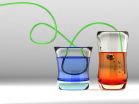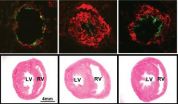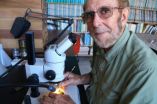(Press-News.org) Only recently has it become possible to accurately "see" the structure of a liquid. Using X-rays and a high-tech apparatus that holds liquids without a container, Kenneth Kelton, PhD, the Arthur Holly Compton Professor in Arts & Sciences at Washington University in St. Louis, was able to compare the behavior of glass-forming liquids as they approach the glass transition.
The results, published in the August 6 issue of Nature Communications, are the strongest demonstration yet that bulk properties of glass-forming liquids, such as viscosity, are linked to microscopic ones, such as structure.
Although people have known how to make glass for thousands of years, the glassy state and the glass transition are still not fully understood. The method used to make most glasses provides a hint of the problem, Kelton said.
A liquid must first be cooled below its freezing temperature (supercooled) without crystallizing. As the temperature of the supercooled liquid drops further, the liquid becomes more and more viscous. Eventually it reaches a point where its molecules or atoms can't move fast enough to accommodate changes in temperature, and portions of the liquid successively jam, or lock in place.
The transition from a liquid to a glass is not a phase transition, like the familiar conversion of water to ice. At the freezing point, water and ice are both states in thermodynamic equilibrium, meaning everything within them is in balance and nothing is driving them to change. Glass, on the other hand, is not in equilibrium at any temperature.
Despite years of study, the process of glass formation still puzzles scientists. For the most part they have only been able to measure bulk properties of glass-forming liquids, such as viscosity and specific heat, and the interpretations they came up with depended in part on the measurements they took. But they were aware that these properties probably reflected changes in the liquid's structure at an atomic level.
Understanding the glass transition is important, Kelton said, because glasses are far more common than people realize. "One day I noticed that some of my nuts-and-bolts papers on the crystallization of glasses were much more highly cited than I would have expected," he said. "It turned out they were being cited by people in the pharmaceutical industry."
Pharmaceutical companies have been developing "amorphous" (glassy) drugs for a variety of reasons. But one reason that amorphous drugs generally dissolve better in the body, so that lower doses are more effective.
But that's just one of many hidden uses for glass science.
Fragile and strong liquids
Kelton chose to study a property called 'liquid fragility,' which appears to play a role in glass formation. The term 'fragility' was first coined in 1995 by Austen Angell, now a professor of chemistry at Arizona State University, who is known for his research on the physics of glasses and glass-forming liquids. Angell felt that a new term was needed to capture dramatic differences in the way a liquid's viscosity increases as it approaches the glass transition.
The viscosities of some liquids change gradually and smoothly as they approach this transition. But as others are cooled, the viscosities change very little at first, but then take off like a rocket as the transition approaches.
Angell could only measure viscosity, but he called the first type of liquid "strong" and the second type "fragile" because he suspected a structural difference underlay the differences that he saw.
"It's easier to explain what he meant in terms of the transition from a glass to a liquid rather than the other way around," Kelton said. "Suppose a glass is heated through the glass transition temperature. If it's a strong system, it 'remembers' the structure it had as a glass—which is more ordered than in a liquid—and that tells you that the structure does not change much through the transition. In contrast, a fragile system quickly 'forgets' its glass structure, which tells you that its structure changes a lot through the transition.
"That 's how Angell viewed it," Kelton continued, "but it had never been experimentally shown. People argued that the change in viscosity had to be related to the structure—through several intermediate concepts, some of which are not well defined. What we did was hop over these intermediate steps to show directly that fragility was related to structure."
Putting glass under the "microscope"
Kelton was able to look at structure because his team has built a new apparatus, the Washington University-Beamline Electrostatic Levitator, or WU-BESL, which was specifically designed to provide a kind of "microscope" to study the atomic structure of liquids, much like a traditional microscope can look into the body of a cell.
In a sense the WU-BESL isn't all that different from the familiar light microscope. But instead of being clipped on a stage, the supercooled sample is levitated in a vacuum to avoid contact with a container or even a floating speck of dust, which could make it suddenly crystallize.
And instead of probing the sample with visible light, which has wavelengths too long to resolve atoms, it probes them with high intensity X-rays. During an experiment, the WU-BESL is carried to Argonne National Laboratory outside of Chicago and installed at the Advanced Photon Source, a particle accelerator that produces an intense beam of X-ray photons.
Once levitated, the sample is melted with a high-power laser and allowed to cool. As its temperature decreases toward the glass transition, the sample is exposed to the X-ray photons and detectors measure the intensity of scattered photons as a function of the scattering angle.
By analyzing the scattered data, the scientists obtain a plot of "the structure factor," an oscillating line with peaks of rapidly diminishing height that contains information on atom locations. Kelton and his colleagues focus on the first of these peaks, which corresponds most directly with the change in the liquid's average structure.
To test Angell's idea, the scientists heated and then cooled many samples of metallic glass-forming liquids, some considered strong and the others fragile, in the WU-BESL. The strong liquid's structure factor evolved gradually from that of a liquid to that of a glass. But the evolution of the fragile liquid's structure factor accelerated abruptly as it approached the glass transition.
It was just as Angell had suspected. The rate of atomic ordering in the liquid near the transition temperature determines whether a liquid is fragile or strong.
These results help us understand some fundamental physics, but Kelton also points out that they have a practical importance, providing glass manufacturers with a new way to search for good glass formers. Strong liquids seem to be good glass formers that "want" to form glasses and ignore inducements to crystallize. Fragile liquids are generally bad glass formers that can be coaxed to make glass only by using extreme manufacturing techniques.
Since 2010, Apple Inc. has had an exclusive rights agreement with Liquidmetal Technologies, a company that make metallic glasses, Kelton said. In May 2014, Apple was granted a patent for "printing" metallic glass bezels for smartphones, which will be stronger than plastic ones, but more flexible than metal ones.
"By learning how liquid structure is related to the formation of liquid glasses," Kelton said, "we open the door a bit wider to the invention of new metallic glasses for novel applications."
INFORMATION: END
Experiments explain why some liquids are 'fragile' and others are 'strong'
'Fragility' provides a clue to the mystery of what happens when a liquid turns into a glass
2014-08-27
ELSE PRESS RELEASES FROM THIS DATE:
Novel 'butterfly' molecule could build new sensors, photoenergy conversion devices
2014-08-27
TALLAHASSEE, Fla. — Exciting new work by a Florida State University research team has led to a novel molecular system that can take your temperature, emit white light, and convert photon energy directly to mechanical motions.
And, the molecule looks like a butterfly.
Biwu Ma, associate professor in the Department of Chemical and Biomedical Engineering in the FAMU-FSU College of Engineering, created the molecule in a lab about a decade ago, but has continued to discover that his creation has many other unique capabilities.
For example, the molecular butterfly can flap ...
A touching story: The ancient conversation between plants, fungi and bacteria
2014-08-27
MADISON, Wis. — The mechanical force that a single fungal cell or bacterial colony exerts on a plant cell may seem vanishingly small, but it plays a heavy role in setting up some of the most fundamental symbiotic relationships in biology. In fact, it may not be too much of a stretch to say that plants may have never moved onto land without the ability to respond to the touch of beneficial fungi, according to a new study led by Jean-Michel Ané, a professor of agronomy at the University of Wisconsin-Madison.
"Many people have studied how roots progress through the soil, ...
Protein in 'good cholesterol' may be a key to treating pulmonary hypertension
2014-08-27
Oxidized lipids are known to play a key role in inflaming blood vessels and hardening arteries, which causes diseases like atherosclerosis. A new study at UCLA demonstrates that they may also contribute to pulmonary hypertension, a serious lung disease that narrows the small blood vessels in the lungs.
Using a rodent model, the researchers showed that a peptide mimicking part of the main protein in high-density lipoprotein (HDL), the so-called "good" cholesterol, may help reduce the production of oxidized lipids in pulmonary hypertension. They also found that reducing ...
Research geared to keep women from fleeing IT profession
2014-08-27
WACO, Texas (August 27, 2014) – For years, employers and experts have been trying to reverse the exodus of women from information technology positions.
They're failing.
Studies show that women are significantly underrepresented in the IT field, and the number of women who've graduated with degrees in computer and information science have plummeted from 37 percent in 1985 to 18 percent in 2011.
The failure to "stop the bleeding" stems, in part, from the industry's reliance on an oft-cited, outdated and under-studied research model, said Cindy Riemenschneider, Ph.D., ...
No cookie-cutter divorces, so what info should online co-parenting classes offer?
2014-08-27
URBANA, Ill. – Required online classes for divorcing couples who have children are good at teaching parents how to deal with children's needs and responses to their family's new situation. But co-parenting couples would benefit from content that helps adults cope with their own emotions and from unique tracks for families with special circumstances such as intimate partner violence or alcoholism, said a University of Illinois researcher in human and community development.
"There is no cookie-cutter divorcing couple, and with online programming, educators are able to supply ...
NASA telescopes uncover early construction of giant galaxy
2014-08-27
Astronomers have for the first time caught a glimpse of the earliest stages of massive galaxy construction. The building site, dubbed "Sparky," is a dense galactic core blazing with the light of millions of newborn stars that are forming at a ferocious rate.
The discovery was made possible through combined observations from NASA's Hubble and Spitzer space telescopes, the W.M. Keck Observatory in Mauna Kea, Hawaii, and the European Space Agency's Herschel space observatory, in which NASA plays an important role.
A fully developed elliptical galaxy is a gas-deficient ...
The high cost of hot flashes: Millions in lost wages preventable
2014-08-27
The steep decline in the use of hormone therapy has spawned a prevalent but preventable side effect: millions of women suffering in silence with hot flashes, according to a study by a Yale School of Medicine researcher and colleagues.
In the study published in the Aug. 27 online issue of the journal Menopause, the team found that moderate to severe hot flashes — also called vasomotor symptoms (VMS) — are not treated in most women. Women with VMS experience more than feeling hot; other frequently occurring symptoms include fatigue, sleep disturbance, depression, anxiety, ...
NASA begins hurricane mission with Global Hawk flight to Cristobal
2014-08-27
The first of two unmanned Global Hawk aircraft landed at NASA's Wallops Flight Facility in Wallops Island, Virginia, on Aug. 27 after surveying Hurricane Cristobal for the first science flight of NASA's latest hurricane airborne mission.
NASA's airborne Hurricane and Severe Storm Sentinel, or HS3, mission returns to NASA Wallops for the third year to investigate the processes that underlie hurricane formation and intensity change in the Atlantic Ocean basin. HS3 is a collaborative effort that brings together several NASA centers with federal and university partners.
The ...
Junk food makes rats lose appetite for balanced diet
2014-08-27
A diet of junk food not only makes rats fat, but also reduces their appetite for novel foods, a preference that normally drives them to seek a balanced diet, reports a study published in the open-access journal Frontiers in Psychology.
The study helps to explain how excessive consumption of junk food can change behavior, weaken self-control and lead to overeating and obesity.
The team of researchers, led by Professor Margaret Morris, Head of Pharmacology from the School of Medical Sciences, UNSW Australia, taught young male rats to associate each of two different sound ...
Nanodiamonds are forever
2014-08-27
Most of North America's megafauna — mastodons, short-faced bears, giant ground sloths, saber-toothed cats and American camels and horses — disappeared close to 13,000 years ago at the end of the Pleistocene period. The cause of this massive extinction has long been debated by scientists who, until recently, could only speculate as to why.
A group of scientists, including UC Santa Barbara's James Kennett, professor emeritus in the Department of Earth Science, posited that a comet collision with Earth played a major role in the extinction. Their hypothesis suggests that ...
LAST 30 PRESS RELEASES:
Scientists trace microplastics in fertilizer from fields to the beach
The Lancet Obstetrics, Gynecology, & Women’s Health: Taking paracetamol during pregnancy does not increase risk of autism, ADHD or intellectual disabilities, confirms new gold-standard evidence review
Taking paracetamol during pregnancy does not increase risk of autism, ADHD or intellectual disabilities
Harm reduction vending machines in New York State expand access to overdose treatment and drug test strips, UB studies confirm
University of Phoenix releases white paper on Credit for Prior Learning as a catalyst for internal mobility and retention
Canada losing track of salmon health as climate and industrial threats mount
Molecular sieve-confined Pt-FeOx catalysts achieve highly efficient reversible hydrogen cycle of methylcyclohexane-toluene
Investment in farm productivity tools key to reducing greenhouse gas
New review highlights electrochemical pathways to recover uranium from wastewater and seawater
Hidden pollutants in shale gas development raise environmental concerns, new review finds
Discarded cigarette butts transformed into high performance energy storage materials
Researchers highlight role of alternative RNA splicing in schizophrenia
NTU Singapore scientists find new way to disarm antibiotic-resistant bacteria and restore healing in chronic wounds
Research suggests nationwide racial bias in media reporting on gun violence
Revealing the cell’s nanocourier at work
Health impacts of nursing home staffing
Public views about opioid overdose and people with opioid use disorder
Age-related changes in sperm DNA may play a role in autism risk
Ambitious model fails to explain near-death experiences, experts say
Multifaceted effects of inward foreign direct investment on new venture creation
Exploring mutations that spontaneously switch on a key brain cell receptor
Two-step genome editing enables the creation of full-length humanized mouse models
Pusan National University researchers develop light-activated tissue adhesive patch for rapid, watertight neurosurgical sealing
Study finds so-called super agers tend to have at least two key genetic advantages
Brain stimulation device cleared for ADHD in the US is overall safe but ineffective
Scientists discover natural ‘brake’ that could stop harmful inflammation
Tougher solid electrolyte advances long-sought lithium metal batteries
Experts provide policy roadmap to reduce dementia risk
New 3D imaging system could address limitations of MRI, CT and ultrasound
First-in-human drug trial lowers high blood fats
[Press-News.org] Experiments explain why some liquids are 'fragile' and others are 'strong''Fragility' provides a clue to the mystery of what happens when a liquid turns into a glass







